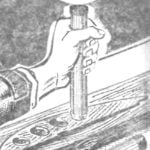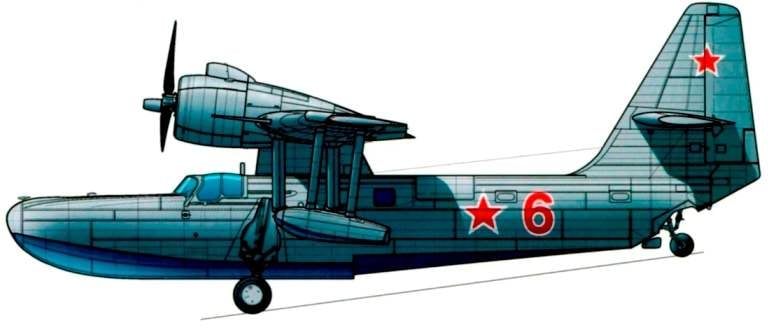Takeoff and landing is allowed at the wave height up to 0.6 m, and wind speed 10 to 12 m/s, which exceeded the requirements of naval aircraft to 0.1 m and 2 m/s, respectively. The only “major” drawback of the machine was a beam, dividing the cockpit in half, constraining the location of the pilots. The rest, judging by the conclusion of the research Institute of the Navy, the aircraft on the main flight and technical data, consistent with the decision of the government and was recommended for serial production.
But the first machine was built another instance, first flying in January 1949, unlike the first prototype, it is, in particular, the Electromechanical system of cleaning and landing gear, replaced hydraulic. Instead of a screw AV-29E-81A set of experienced AV-29B-81A, equipped with a defrost, the trim tab on the ailerons and pneumatically operated frontal folds of the hood of the engine.
Both the be-8 for some time were on the factory Parking lot. On one of these machines, piloted by V. M. Tsepilova and S. I. Kondratenko, in 1949, chief designer G. M. Beriev, accompanied by I. G. Kozelsky repeatedly overflying the black sea coast of the Caucasus in search of a non-freezing waters for a test base.
Beriev chose on Gelendzhik Bay. It meets all basic requirements and in addition, on the West Bank during the war was stationed a unit of marine aviation, which remained concreted hydropack. Soon in Noumea buildings were built to service the flight-experimental base and test went without seasonal breaks.
During the operation one of the machines crashed. During the landing collapsed the attachment of one of the side floats, but it was an accident and the incident does not denigrate the car and its characteristics.
Despite the insistence of the command of the fleet in mass production amphibious went. For the be-8 was not a manufacturing base. Factory serial No. 86, near OKB G. M. Beriev Taganrog, passed for the production of landing gliders Il-32. The draft plan of the Ministry of aviation industry in 1948-the year stated that “the holding of improvements is impractical, because the aircraft’s prospects for the launch of a series does not have.”
But despite successful testing and positive feedback from testers, “issue “Annushka” married”, as sadly joked Georgy Mikhailovich Beriev, failed. Neither the military nor civil aircraft customers are not interested in.
But the be-8 has entered the history of aviation not only because of the perfect his side is “discovery”. It is in the framework of scientific research “radium-L” worked out the installation of hydrolic and “radium-K” — hydrofoils.
Project runway devices hydrolyzate for the be-8 was developed in research Institute No. 15 Navy. Preliminary design approved April 6, 1955 The layout of the hydrofoils for amphibians was developed by the 12th laboratory TSAGI, specializing in the problems of high-speed hydrodynamics.
Plane mounted underwater wings of type KS, consisting of the two front V-shaped bow units and T-shaped feed. All wings had supercavities profile, used in hydraulic canals TSAGI.
Amphibian Be-8 afloat
Be-8 to chassis ground
Hydrolyze and underwater wings attached to the aircraft using components of the captured land chassis. In this form Be-8, of course, ceased to be amphibious machine, and therefore, for lowering and lifting hydroplanes used a special roll-out chassis consisting of two main trucks and the tail of the device.
Flight tests of the be-8 hydrolyzate was carried out in the Baltic sea, June — July, hydrofoil — July — September 1956, in the Eastern part of the Gulf at wind speeds from 0 to 9.2 m/s and wind wave height from 0 to 0,7 m.
The first domestic flight of a seaplane, equipped with underwater wings, with landing speeds in excess of 100 km/h took place on 20 July 1956 during the tests was made 29 runs in different modes of operation of the engine 22 and the flight. The seaplane was piloted by senior test pilot Colonel F. S. Leshchenko.
According to test results, it was concluded that the underwater wings provide a normal takeoff and landing of a seaplane and can be recommended as landing devices on new machines. Piloting techniques Be-8 hydrofoil turned out to be easier than in a conventional boat.
Although conducted flight experiments gave interesting results, implementing them on production machines failed due to the significant complication of the design of seaplane and of increasing the resistance in air and in water. Improving the performance of separation, hydrolyze and underwater wings were taken away a considerable part of the power, delaying the release of the boats at redan. For aircraft such a mass of these devices proved to be ineffective.
Performance characteristics
Engine…………………………………..AL-21
Power, HP……………………………….1×700
Length, m…………………………………………….13
Height, m………………………………………..4,48
Wing span, m………………………………….19
Wing area, m2……………………………..40
Maximum takeoff weight, kg…….3800
The maximum amount of fuel, kg………320
Maximum payload, kg 400…
Maximum speed
(1800 m), km/h……………………266
The take-off speed, km/h……………………110
Landing speed, km/h………………..100
Practical ceiling, m………………..5550
Takeoff run (water), m…………………….300
Takeoff run (land), m…………………..270
Flight range with maximum
fuel reserve, km………………………..1205
Crew/passengers, people………………1-2/4-6
Recommend to read
 DUMP CART
DUMP CART
To make this light and convenient cart — an indispensable helper for gardeners and farmers — you will only need what can be found in any dacha or farm. But it will serve on any auxiliary... HOW TO EASE RIB
HOW TO EASE RIB
Modelers know how difficult it is to facilitate fine rib, without violating its strength. In the model airplane circled our House pioneers a way of cutting out successfully replaced the...
 Amphibian Be-8 has completed the collection of seaplanes, which began in 1941 scout KOR-2 (be-4). Despite the relatively high assessment from specialists, Be-8 for a number of reasons, mass production has not been, and was used mostly as a flying laboratory. Work on the be-8 began in 1946 on the basis of the technical project of the ship’s scout LL-145 with the start of ejection. As a prototype, a new amphibious aircraft was a flying boat of all-metal construction, made on a parasol. Wing, who were technologically on the center section and two detachable parts, were recruited from the profiles of WT-230. On its consoles housed fixed landing gear floats lateral stability, and on the back edge landing flaps, uklonivshiesya on take-off 15° landing 40°. In the wings were the fuel tanks.
Amphibian Be-8 has completed the collection of seaplanes, which began in 1941 scout KOR-2 (be-4). Despite the relatively high assessment from specialists, Be-8 for a number of reasons, mass production has not been, and was used mostly as a flying laboratory. Work on the be-8 began in 1946 on the basis of the technical project of the ship’s scout LL-145 with the start of ejection. As a prototype, a new amphibious aircraft was a flying boat of all-metal construction, made on a parasol. Wing, who were technologically on the center section and two detachable parts, were recruited from the profiles of WT-230. On its consoles housed fixed landing gear floats lateral stability, and on the back edge landing flaps, uklonivshiesya on take-off 15° landing 40°. In the wings were the fuel tanks.